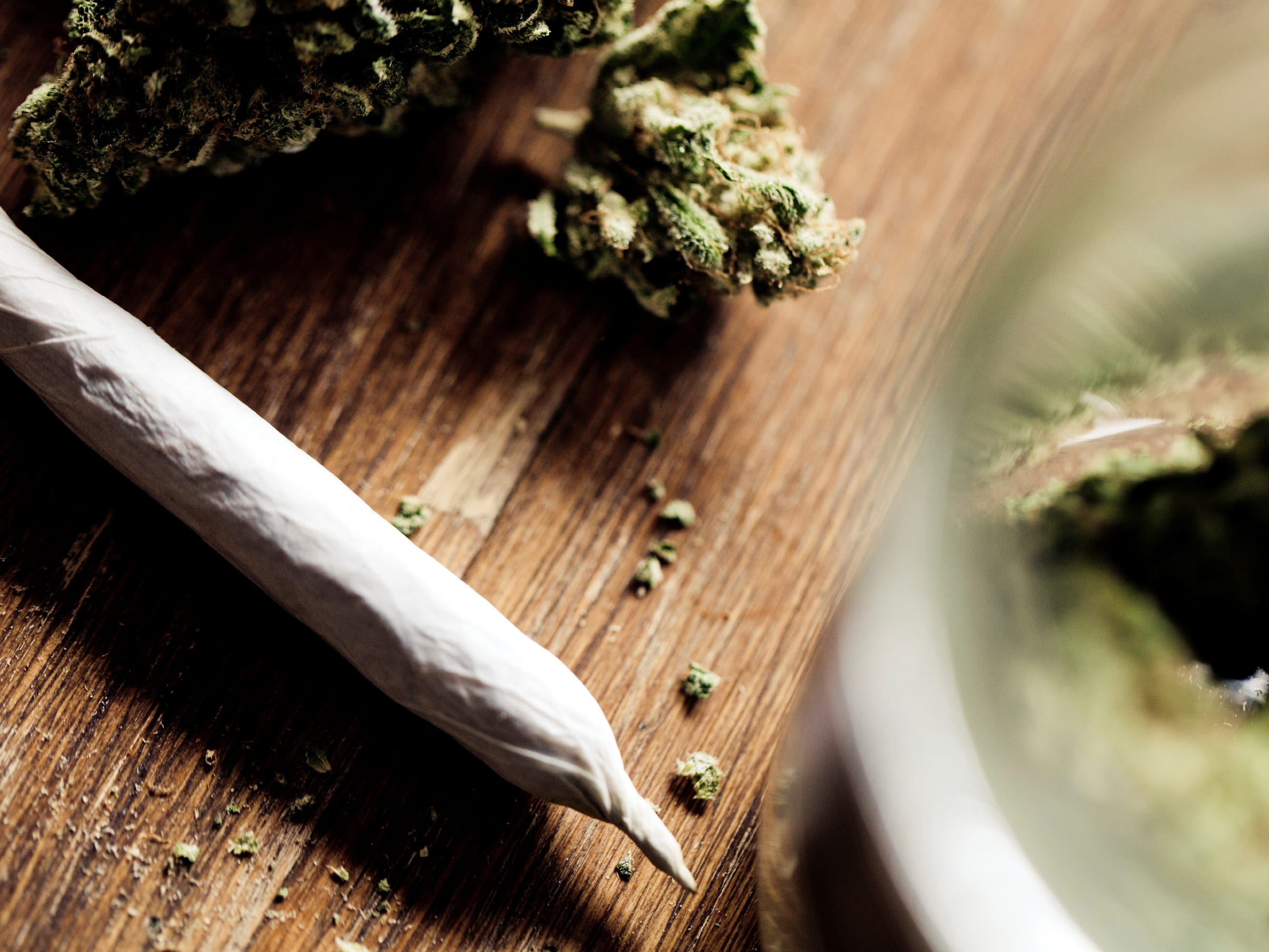Marijuana: Risks and Effects

The Bottom Line
Marijuana is the most common illicit drug in the US. A few states have decriminalized small amounts of the drug. Some permit medical uses. Marijuana is usually smoked. Effects include altered mood, impaired coordination, and impaired judgment. More severe effects sometimes occur. There is no antidote; treatment is supportive. The drug is sometimes addictive.

The Full Story
Marijuana (also known as pot, weed, reefer, ganja, Mary Jane, and other slang terms) refers to the dried leaves, flowers, and stems from the hemp plant Cannabis sativa. They contain the psychoactive (mind-altering) chemical THC (tetrahydrocannabinol), as well as a number of other related compounds called cannabinoids. Concentrated THC is found in hashish and hash oil.
Marijuana is usually smoked in cigarettes called "joints" or in pipes. It can also be mixed in food, such as brownies, cookies, chocolate, and many others, or brewed as a tea and consumed as a beverage. When marijuana is smoked, the THC passes rapidly from the lungs into the bloodstream, which carries the chemical to the brain and other organs throughout the body. It is absorbed more slowly when swallowed in food or drink.
The "high" and other effects that users experience from marijuana can include altered mood and perception, a fast heart rate, impaired coordination, difficulty with problem solving and "normal" thinking, and forgetfulness. Impaired judgment makes it dangerous to drive after using marijuana. People under the influence of marijuana may also be at greater risk of sexual assault or other criminal acts. Psychotic episodes and more serious medical problems are rare but possible.
Most adults under the acute influence of marijuana can manage without medical assistance. Effects typically last for one to three hours.
People who use marijuana often can develop a cough and bronchitis and could become addicted. Some chronic users may develop psychiatric illness, though it's unknown if marijuana is a direct cause. There is some evidence that chronic users are at risk of lung cancer. There is a lot of research but as yet no standard treatments for withdrawal from marijuana.
Marijuana is considered to be the most common illicit drug used in the United States. Its use has been increasing over the last few years, likely due to a diminishing perception of the drug's risks. This may be associated with increased public debate over the drug's legal status. Although the United States federal government considers marijuana to be a Schedule I substance (having a high risk for abuse and no medicinal use), a few states have legalized marijuana for adult recreational use. Many states and the District of Columbia have passed laws allowing its use as a treatment for certain medical conditions.
With the rise in "medical marijuana", many commercially available products containing marijuana or THC (such as candy bars, cookies, and drinks) are now available in states that have decriminalized marijuana use. Children and pets can become poisoned by eating or drinking what appears to be a chocolate bar, but actually contains a large amount of marijuana or its active ingredient.
Robert Porter, PharmD, MPH
Certified Specialist in Poison Information
Rose Ann Gould Soloway, RN, BSN, MSEd, DABAT emerita
Clinical Toxicologist
Prevention Tips
- Talk to pre-teens and teenagers about illicit drug use, including marijuana.
- Do not drive or operate heavy machinery while under the influence of marijuana.
- If anyone in your household is taking medical marijuana, especially in a "food" or "candy" formulation, make certain to keep it locked away and well out of reach of any children.
This Really Happened
Case 1: A previously healthy 18 year old was seen in the emergency room because he had seizures. He said that his "heart began feeling weak" after smoking marijuana the previous evening. He did not have any past medical history to suggest he had heart disease, nor did he have a history of seizures in the past. The patient spent the night in the intensive care unit (ICU) for observation, and later it was discovered he had developed a type of abnormal heart rhythm called atrial fibrillation (also known as AF or "a fib"). The medical team that treated the patient suspected the abnormal rhythm was most likely caused by the seizures he had after smoking marijuana the night before.
The patient was successfully treated for his seizures, but left "against medical advice" after an overnight stay in the ICU and did not attend his follow-up appointments. Although marijuana is increasingly becoming viewed as a relatively "safe" drug, given the recent legislation to decriminalize its use in certain states, it is not without risk and has the potential to cause life-threatening symptoms in young, healthy people.
Reference: Singh D, Huntwork M, Shetty V, Sequeira G, Akingbola O. Prolonged atrial fibrillation precipitated by new-onset seizures and marijuana abuse. Pediatrics. 2014;133:e443-e446.
Case 2: An adult female inadvertently took a bite of a commercially prepared candy bar that contained medical marijuana, as she thought it was simply a chocolate bar. The marijuana-containing candy bar was not hers, and she suspected it was something her adult son, who lives with her, may have purchased.
The label on the marijuana-containing candy bar stated it contained 35 mg of THC in each serving, or a total of 210 mg in the entire bar.
Within the next two hours, the patient was taken to the emergency room and was having some confusion, thirst, and difficulty concentrating. Her symptoms resolved within a few hours and she was discharged from the hospital the following day.
For More Information
Medical Marijuana: Safe Storage Can Prevent Childhood Poisonings (The Poison Post®)
References
Crean RD, Crane NA, Mason BJ. An evidence-based review of acute and long-term effects of cannabis use on executive cognitive functions. J Addict Med. 2011;5:1-8.
Institute of Medicine (US); Joy JE, Watson SJ Jr., Benson JA Jr., editors. Marijuana and Medicine: Assessing the Science Base. Washington (DC): National Academies Press (US); 1999.
Kogan NM, Mechoulam R. Cannabinoids in health and disease. Dialogues Clin Neurosci. 2007; 9:413-430.
Volkow ND, Baler RD, Compton WM, Weiss RB. Adverse health effects of marijuana use. N Engl J Med 2014;370:2219-27.
Prevention Tips
- Talk to pre-teens and teenagers about illicit drug use, including marijuana.
- Do not drive or operate heavy machinery while under the influence of marijuana.
- If anyone in your household is taking medical marijuana, especially in a "food" or "candy" formulation, make certain to keep it locked away and well out of reach of any children.
This Really Happened
Case 1: A previously healthy 18 year old was seen in the emergency room because he had seizures. He said that his "heart began feeling weak" after smoking marijuana the previous evening. He did not have any past medical history to suggest he had heart disease, nor did he have a history of seizures in the past. The patient spent the night in the intensive care unit (ICU) for observation, and later it was discovered he had developed a type of abnormal heart rhythm called atrial fibrillation (also known as AF or "a fib"). The medical team that treated the patient suspected the abnormal rhythm was most likely caused by the seizures he had after smoking marijuana the night before.
The patient was successfully treated for his seizures, but left "against medical advice" after an overnight stay in the ICU and did not attend his follow-up appointments. Although marijuana is increasingly becoming viewed as a relatively "safe" drug, given the recent legislation to decriminalize its use in certain states, it is not without risk and has the potential to cause life-threatening symptoms in young, healthy people.
Reference: Singh D, Huntwork M, Shetty V, Sequeira G, Akingbola O. Prolonged atrial fibrillation precipitated by new-onset seizures and marijuana abuse. Pediatrics. 2014;133:e443-e446.
Case 2: An adult female inadvertently took a bite of a commercially prepared candy bar that contained medical marijuana, as she thought it was simply a chocolate bar. The marijuana-containing candy bar was not hers, and she suspected it was something her adult son, who lives with her, may have purchased.
The label on the marijuana-containing candy bar stated it contained 35 mg of THC in each serving, or a total of 210 mg in the entire bar.
Within the next two hours, the patient was taken to the emergency room and was having some confusion, thirst, and difficulty concentrating. Her symptoms resolved within a few hours and she was discharged from the hospital the following day.
